Looking to improve your sourdough bread? This technique will do it! Learn how to stretch and fold sourdough with my easy step-by-step instructions and video.
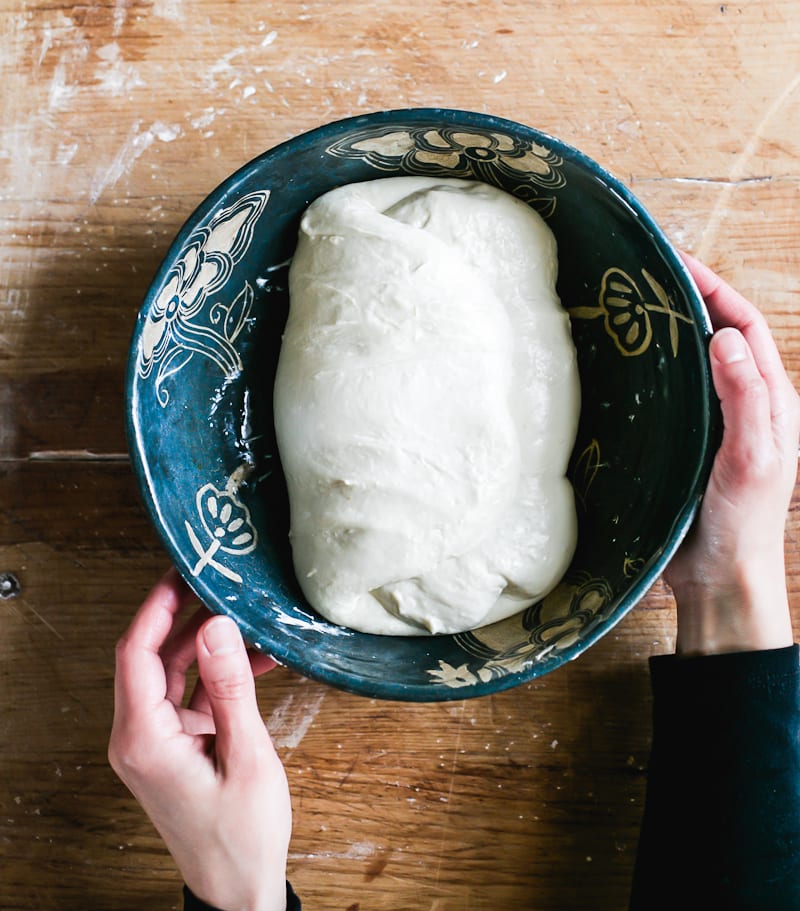
Bakers use the stretch and fold technique to improve the quality of their sourdough bread.
When done correctly, it will strengthen the gluten and gently incorporate air into the dough without kneading. I talk more about this in my book Artisan Sourdough Made Simple. But for now: the benefit is an increase in volume, a lofty high rise, and if you’re lucky a more open interior crumb. Plus, it’s the most satisfying sensory experience (who doesn’t love touching bread dough?!).
The technique can be done on the countertop or directly in the bowl; the latter option is what I’m showing you here.
- Stretch the dough upward
With lightly wet fingertips, grab a portion of the dough and stretch it upward.
- Fold the dough
Fold the dough over toward the center of the bowl.
- Stretch and fold
Give the bowl a one-quarter turn and repeat: stretch the dough upward and fold it over toward the center.
- Stretch and fold again
Continue until you have come full circle to complete 1 set, or 4 folds around the bowl.
Baker’s Tip: When you do the first fold, the dough will feel loose and elastic. As you continue, the dough will start to tighten up, usually around the 3rd or 4th fold. After about 2-4 sets, the dough will go from flat and dense to plump and jiggly. That’s how you’ll know the technique is working.
How Many Times Should You Stretch And Fold the Dough?
Stretch and folds are completed in sets.
The first set is usually done about 30 minutes into the bulk rise.
Then, you’ll complete up to 4 additional sets spaced about 15 minutes to 1 hour apart, depending on the dough’s flexibility and your own personal baking schedule.
Baker’s Tip: As a general rule of thumb, the sets for high hydration doughs (wet dough) can be spaced closer together because the dough is slack; about 15-30 minutes apart. For low hydration doughs (dry, stiffer dough), the gluten will need more time to relax, about 30 minutes to 1 hr. Otherwise it won’t stretch properly. As always, these are suggested timeframes. Watch the dough and not the clock!
So, Is It Worth it?
Absolutely!
Once you get the hang of it, you’ll find ways incorporate the stretch and fold technique into your baking routine. And with practice and repetition, you’ll notice changes in the look, taste and feel of the sourdough bread. Just remember: not all doughs require it. However, it’s easy, practical and super effective when applied as an optional step.
Baker’s Tip: When you stretch and fold the dough it may (or may not) look similar to mine. This is normal. It might be stiffer or even looser; it all depends on the specific recipe you’re following. For reference in the video above, I’m using a dough that is approximately 70% hydration.
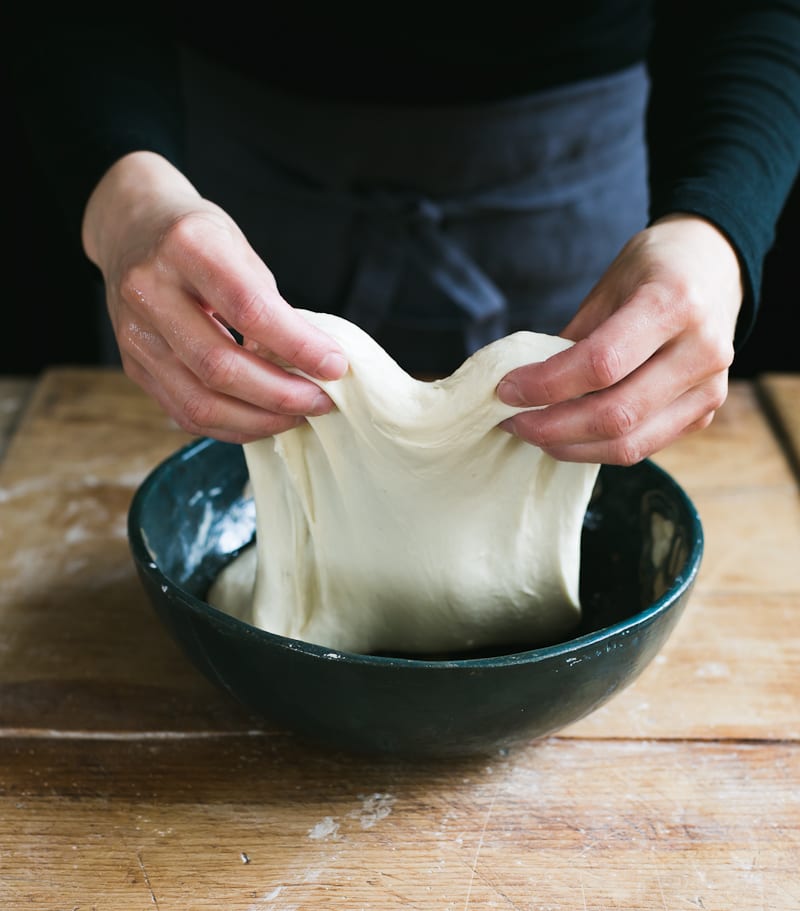
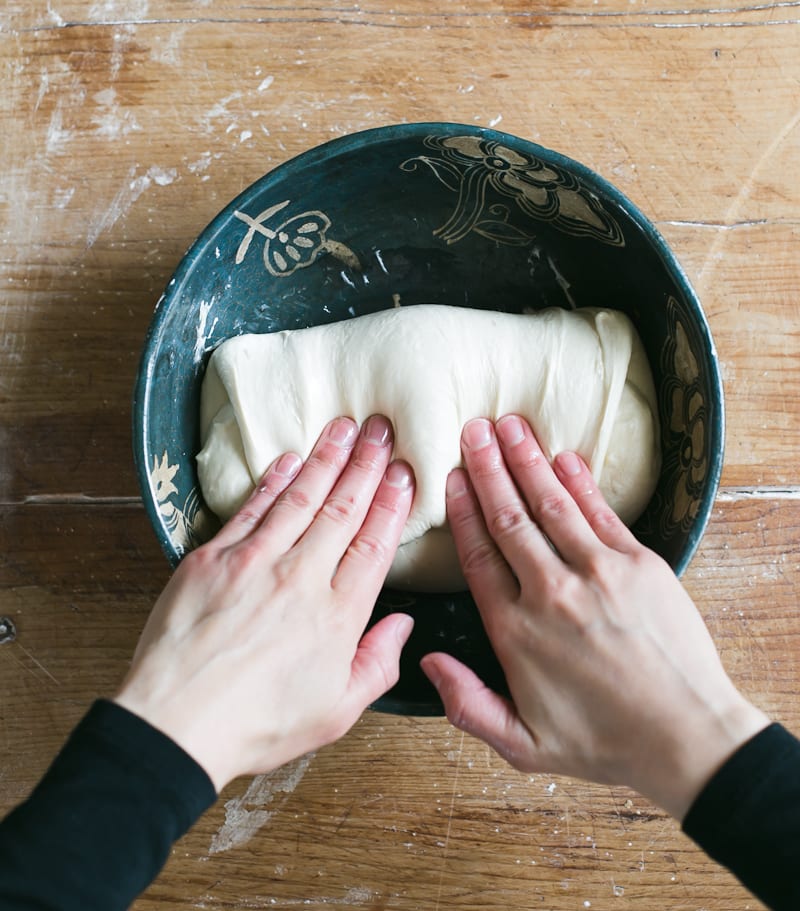
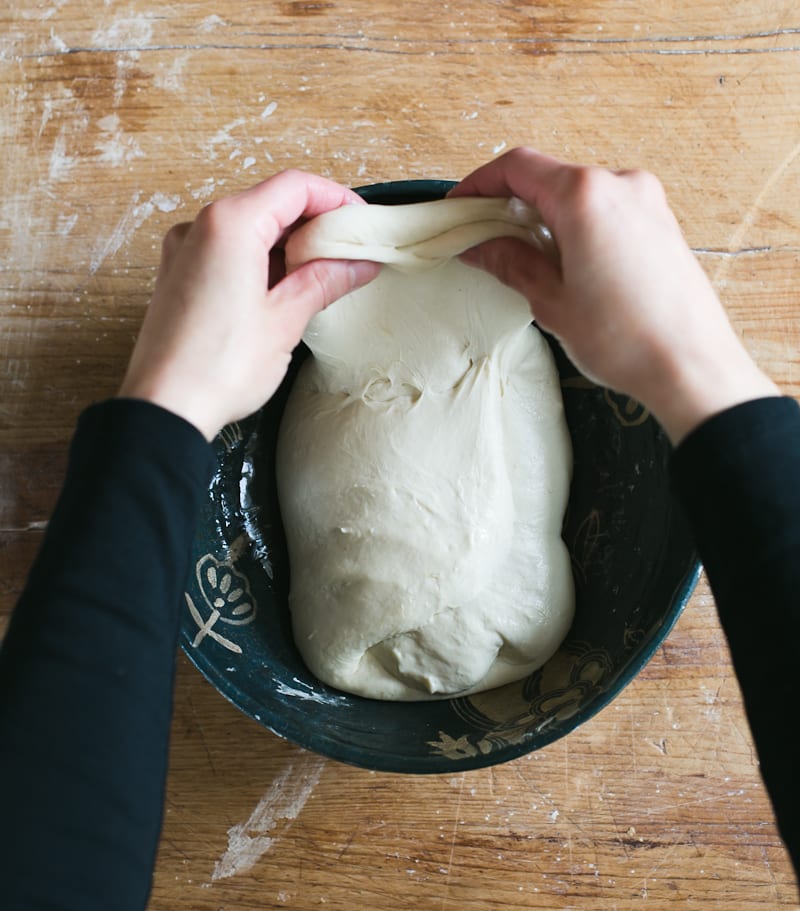
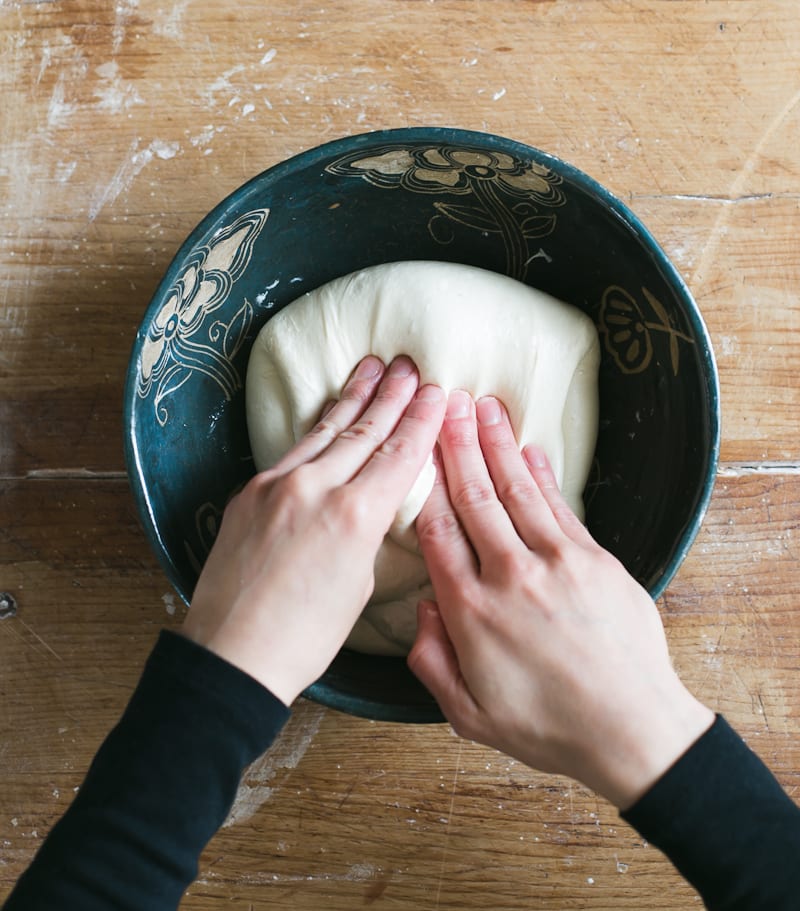
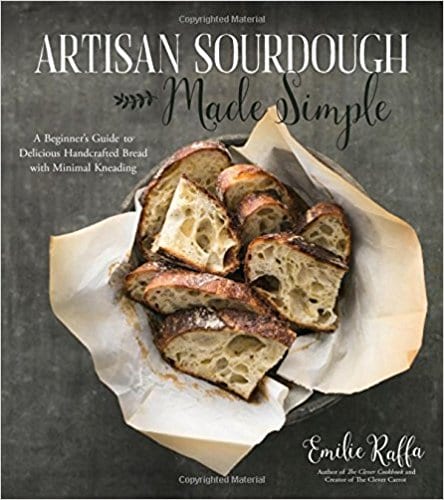

Comments
Lisa says
i am new to sourdough. and have tried to add the stretch and fold. this step is a little confusing to me. sets! 4 folds how many times to make a set? and my dough is thick to stretch it I kinda have to pull it and it will tear. my 2 time making the bread has went really well. the bread has turned out excellent. but would love to understand this step more.
Emilie Raffa says
Hi Lisa! Generally speaking, 4 folds = 1 set. If your dough is tearing when doing the folds, it needs more resting time in between sets. Resting time will vary depending on the recipe you’re following. For example, when you look at stretch and fold videos on social media, those doughs are usually high-hydration (wet doughs) that are very stretchy. They typically follow a short rest of 20-30 minutes. For low-hydration doughs (dry doughs) try 30 minutes to 1 hour rest to allow the dough to become more pliable.
Tara Sprunger says
Why do some recipes say to turn the bowl 90° before making a second stretch in fold and yours says to turn it 45°?
Rose says
Amazing recipe! I can’t believe how easy it is. My first starter was ready about 10 days ago. I have not made two outstanding loaves of sourdough artisan bread. I have been feeding it now daily, about to make my third loaf. Yummy!
Cindy says
I am just beginning and am interested to see how many different techniques are used. I have read so many “what you need to know”, but details are left out; ie, starter should be at room temp??? Use a scale, and zero out as you add ingredients. Just little things make a huge difference.
JoAnn says
I hope you can answer my question I have searched and cannot find. I am a beginner and use King Arthur organic bread flour. Elaine Bod says beginners shouldn’t use organic but does not say why. I have made 8 very good tasting bread and they do rise but seem dense to me. Thank you so much
Christina says
This is a dense or tight crumb recipe, the higher hydration or more water you use will determine your crumb as well as the strength of your starter etc.
Richard says
This is similar to an Italian method used for making a pan pizza dough I like, except you lift the dough and let it fold down on itself, also rubbing some olive oil on the dough helps with the stickiness.
Joan Rond says
This post was extremely helpful. I have been really pleased with the results of my sourdough bread using Emily’s tips.
Tracey says
Dear Emilie,
I made my first Sourdough following your beginners guide. I danced in the kitchen when I took it out the oven – great excitement. Knowing I can produce a very reasonable Sourdough is fantastic; my next step is to practice, practice, practice.
Thank you! there are so many techniques out there; yours felt right for me as a beginner. Your book is on its way.
🤗🏴
Tracey
Rosalyn says
Started a bulk rise and did a first fold. The dough seems tight. Any remedy other than time to just wait and see what happens or is it a sign that my starter may not have enough activity to push this along?
Joanne Johnston says
Love the Artisan book. Have made many of the breads. Always turns out wonderful. Enjoy!
Jonah says
I’m so anxious to bake it. The starter is the time consumer. I live in Mexico City, does the 3000 feet altitude hinder any process? Got
And can I use regular flour instead of bread flour?
Carlton d Spain says
does it matter if you are using all purpose flour or bread flour or double zero flour, i like neopolitan style pizza crust which calls for double zero flour. i’m trying to adjust the fold and stretch with the proper flour for the recipe. some flours are not as durable and can not be stretch and folded as much. thanks
Nicole says
I feel like my dough is always so thick and stiff feeling after the autolyse!!! I’ve added more water, but I’m afraid of adding too much and not being able to shape my dough. Any tips?!
Michael LaVerne Dawes says
Very good getting information fast and to the point
Yin says
Hi Emilie!
Thank you so much for your detailed instructions on how to enter the world of sourdough from starter to bread etc!! I’ve just been given a Dutch oven & am excited to explore baking sourdough bread etc.
Just a quick question – I have wholemeal (ie not wholemeal flour). Can this be used to make the starter?
Look forward to your advice. Thanks!
Regards
Yin
Raj Aggarwal says
Great tips
Ani says
In your directions you say not all doughs require the stretch and fold method. What types of dough would you not use the method?
Russ says
Why doesn’t anyone show a video of performing the first set of stretch and folds. This is where the process is messiest and where newbies (like me) feel things aren’t going the way we expected. Your video shows your dough with structure already, and where it is smooth and silky with enough consistency not to tear. Help me out with a video of the first set, please.
Sourdough Junkie says
The old timers did not use scales! Remember! Where ever you might get or buy a starter from: Alaska or Florida etc; it will become the starter where you keep it, and not be the same from where it came from. The new wild yeasties from your home or garden patio shelf will become dominate and the original strain will be lost. Let your starter catch wild yeasties when possible outdoors in all seasons and weather: Not freezing, catching rain, dust etc. So save your money and make your own, then you must name it; mine is 1946 Willys. 4 stars.
Ulanda says
Hi there!
Needing some help.
I had a very active starter, 1:1:1 ratio, pretty thick.
When I stretch and fold my sourdough, it doesn’t really work. It’s “tough” per se, and won’t stretch so I just end up using two hands and forcefully pulling it over. I started the bulk rise hours ago and it really doesn’t rise much in between my attempts to stretch and fold.
Thoughts on what could be going on? 😣
Amber says
Probably needs more water/hydration?in the notes it says u can add up to 75ml more water and her dough looks to be alot more moist than mine when I followed the recipe without reafing tge notes originally
Nigel says
Thank you so much. I am a real beginner but I love the way you make it sound easy. I will continue to follow you (on social media), not literally 🤣
Corinne F Ibbitson says
I made this this morning. I did skip the stretch and fold. I am sorry I did. Next time I will definitely do this step. I think you should put this step before the “Bulk Rise” as I missed the step. Also my bread didn’t brown very much. It was dense but super tasty. Nothing a little butter and honey can’t fix. Thanks for all the help!! Great suggestions for us beginners!
Glenda says
Just deciding whether to try it. You make it look like something I can accomplish and enjoy!
Christine Baillargeon says
I am new at making Sourdough bread. I used my friend’s recipe for starter and I don’t know what I did wrong because my starter smelled like vomit and my bread was flat. I need some help.
Christina says
Your yeast died. You might need a new starter. I was super confused about the starter part when I first started (haha) and I realized that I was feeding too much water and not enough flour. So I changed it up and it helped me quite a bit. My first two tries at sourdough weren’t pretty. lol
Amy says
My first homemade starter just became active today! Thank you for the great step by step instructions!!
5 stars!!
Amy says
My first homemade starter just became active today! Thank you for the great step by step instructions!!
Kelli says
Very helpful explanations and videos!
Even though I know these techniques I always go back and read/watch your tutorials, and refer to your tips and techniques. TY for taking the time to post!
Emilie Raffa says
Ahhh. this is so great to hear. Thank you so much Kelli! I’m glad you’ve found them helpful :)
Mike K says
First time sourdough maker. I found this advice very easy to understand. Clear, simple and also confidence building. I’m hooked !!!